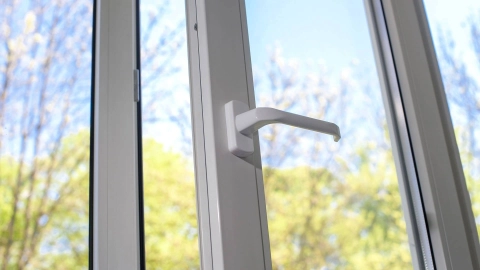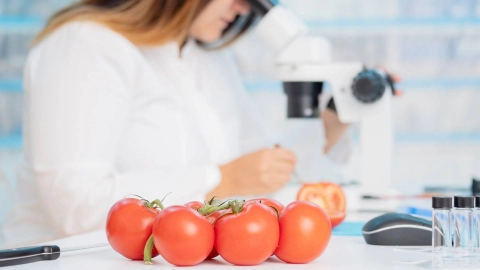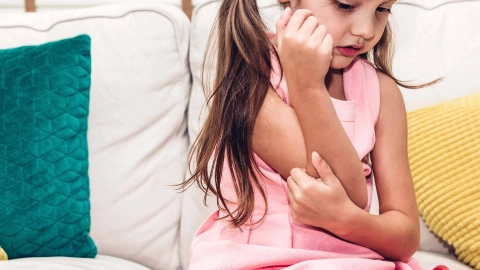Healthy living Household chemicals: identifying and avoiding potential risks
Laundry detergents, washing-up liquids and cleaning agents contain various different chemicals. If used improperly, these can negatively affect people’s health. This article explains how people can protect themselves and others against potential risks.
At a glance
- If used incorrectly, household chemicals can pose a health risk.
- Contact with the eyes or skin can cause irritation, chemical burns and allergies.
- If swallowed, poisoning may occur. Infants are particularly at risk.
- It is important to act quickly following an accident involving household chemical products.
- Those who pay attention to certain things when buying and using household chemicals can protect themselves and others from health risks.
Note: The information in this article cannot and should not replace a medical consultation and must not be used for self-diagnosis or treatment.

What should you do in an emergency?
Despite all precautions, accidents or mix-ups can sometimes still occur. These result in undesired contact between the chemical products and the body or the accidental intake of chemical products. Even though it is rare for most household chemicals to cause severe poisoning, a rapid response is still required.
Administer first aid
Following contact with or the ingestion of small amounts of typical household products such as all-purpose cleaners, dishwasher cleaners and toilet cleaners, the following first aid measures should be performed:
- Ingestion: rinse the mouth with water then drink a little water.
- Eye contact: rinse carefully under warm, running water for about 10 minutes and consult an ophthalmologist if symptoms persist.
- Skin contact: rinse with water and change any damp clothing.
What to avoid
There are certain things that should not be done in the event of (suspected) poisoning:
- drink carbonated drinks or milk – instead, drink water or tea
- induce vomiting, for example by drinking salt water
- take home-made carbon preparations – they are not always suitable and should only be used in consultation with a poison control center or doctor
Obtain medical advice
In case of uncertainty, poisoning or suspected poisoning, do not hesitate to contact a poison control center. The poison control centers are contactable 24 hours a day. The following information is important when making a call:
- Who is affected? How old is the person and how much does he/she weigh?
- What has been taken? Here, it can be helpful to have the packaging to hand for reference. Hazardous products often have a 16-digit UFI code (usually next to the barcode or the hazard pictograms) that can be used to quickly identify the product during a call. This UFI code helps the consultant in the poison control center clearly identify the product formulation.
- How much was taken and when?
- How was it taken – swallowed, inhaled, eye contact, skin contact?
- What are the patient’s symptoms?
- What has already been done?
- Who is calling (name and phone number for the call back)?
Hazardous products often display a 16-digit UFI code on their label. This makes it possible to quickly identify them.
For a complete overview of emergency phone numbers for poison control centers, see the website of the Federal Institute for Risk Assessment (BfR).
Important: In the event of life-threatening symptoms such as a loss of consciousness, seizures, severe respiratory or circulatory problems or cardio-respiratory arrest, call the emergency number 112 immediately.
How do chemicals get into households?
Chemicals have become an almost integral part of modern households. They are found in various products, such as washing powder, cleaning agents and adhesives.
Chemical substances are not automatically harmful to health or toxic. The term “chemicals” refers to substances that have been industrially manufactured.
Chemical products can be very useful in the home, for example to thoroughly clean clothes, bathrooms and kitchens. However, some chemicals found in homes can negatively affect health – at least if they are used improperly or unintentionally come into contact with the body. They can also poison people if swallowed.
The careful, economical and correct use of chemical agents prevents health problems. It is also very important to store household chemicals out of the reach of children.
What are the health risks?
If used properly, most household chemicals do not pose any risk to health. However, improperly using chemicals or mistaking them for other things may affect people’s health – and can sometimes even be dangerous.
Irritation and chemical burns
Even in small quantities, aggressive cleaning agents such as chlorine cleaners can cause irritation and chemical burns as a result of skin contact, as they attack the skin’s protective acid mantle.
To prevent this, it is advisable to wear rubber gloves when cleaning. The eyes can also be severely irritated or burned if they come into contact with certain chemicals. Protective goggles should therefore always be worn when using corrosive or irritant agents. Information about health risks can be found on the packaging.
Allergies and eczema
The human body can show allergic reactions to many different substances, including both naturally occurring substances such as pollen and chemical ingredients in cleaning agents such as fragrances. There are 26 fragrances that are considered to be particularly allergenic, including citral, farnesol and linalool. Fragrances are contained in products such as laundry detergents, cleaning agents and fabric softeners. In the event of direct contact with these products, for example when cleaning without rubber gloves, the fragrances can transfer to the skin, where they can trigger contact allergies and intolerances. They can also cause skin inflammation known as eczema.
Poisoning
The term poisoning is used if a substance that is harmful to health enters the body via the airways, mouth, skin or eyes and harms it. Household poisoning is most common in children, for example due to swallowing cleaning agents. According to the poison control centers, most household poisoning incidents involve foaming cleaning agents such as all-purpose cleaners, washing-up liquid or laundry detergent. However, these do not usually cause serious poisoning. The same cannot be said of oven sprays or barbecue, toilet, chlorine or pipe cleaners: these products are particularly dangerous.
Risk of suffocation
Although the risk of foaming products poisoning someone is low, the increased formation of foam after being swallowed is a risk: if the foam or vomit enters the airways, this can result in inflammation of the lung tissue and breathing problems or even suffocation. To prevent excessive foaming, people can drink or give their child a defoamer with the active ingredients dimethicone or simethicone. Households with children are advised to keep a defoamer in their medicine cabinet.
Swallowing even the smallest amounts of lamp oil or barbecue lighter fluid can cause serious respiratory problems.
Hazardous mixtures
Caution should be exercised when using multiple cleaning agents at the same time or one after the other. Several combinations can react with each other and result in a health risk. For example, chlorine gas is produced when chlorine cleaners are mixed with descalers or other acidic cleaners. If chlorine gas is inhaled, it can cause severe and long-lasting damage to the lungs. Chlorine gas can also be produced when using a chlorine cleaner and a descaler one after the other. It is therefore important to ventilate the area well and wait a while before reaching for the next cleaning agent.
How can harmful chemicals be identified?
Labels indicating low health risks
When purchasing household products, it is possible to check for certain safety and environmental labels to minimize the use of household products that could damage health and the environment.
For many products, the European Union environmental label (“EU Ecolabel”) or German “Blue Angel” label provides reliable information about environmental and health compatibility. These ecolabels indicate products that pose far fewer risks to health and the environment than comparable products. In addition to laundry detergents, cleaning agents, washing-up liquid and soap, these labels can also be found on several other environmentally friendly products such as toilet paper and building materials.
Further information on the ecolabels can be found at blauer-engel.de and eu-ecolabel.de.
Hazard symbols for health risks
If a product poses a health risk, this has to be indicated on the packaging by means of a hazard label comprising a signal word, indications of the risk(s), safety instructions and a hazard symbol (hazard pictogram). The use of such products should ideally be avoided or minimized to the greatest possible extent. If you want to or have to use such products, always take the hazard information on the label seriously and protect yourself against direct contact, for example by wearing rubber gloves and protective goggles when using irritant and corrosive substances. The safety instructions are also displayed on the product label.
Examples of hazard labels include:
- Exclamation mark: products that are harmful to health, irritant or narcotic
- Health risk: e.g. products that can cause severe breathing problems or cancer when swallowed
- Skull and crossbones: chemical products that trigger poisoning in even the smallest amounts and can be life-threatening if they get onto the skin or are swallowed or inhaled
- Corrosive: products that can cause severe burns to the skin or eyes
- Flame: solvents that are highly flammable
How can people protect themselves and others against the potential risks?
Avoid aggressive agents as much as possible
Aggressive and intensive cleaning agents are only really needed on rare occasions. Superficial dirt can be removed with a damp cloth alone. On the other hand, cleaning agents should still be used in the bathroom and kitchen, for example. In these cases, pH-neutral cleaners are ideal as they have good skin compatibility.
Never transfer chemical products into food containers
Most household chemicals do not pose any health risks if used correctly. However, this changes if they are accidentally ingested in large quantities, e.g. swallowed. To prevent this and avoid confusion, cleaning agents and other chemical products should never be transferred into drink or food containers.
Important: household chemicals should never be transferred into other containers.
If you descale your kettle, you should ensure that no-one accidentally uses its contents during the process. Stick a label on the kettle indicating that it is currently being descaled and the contents must not be drunk. After descaling, rinse the kettle with clean water several times to remove all residues.
Store out of reach of children
In households with children, all chemical products should be stored out of their reach. This especially applies to particularly dangerous products such as pipe, oven and barbecue cleaners. These can burn the skin and mucous membranes. Caution should also be exercised with laundry gel capsules (“liquid caps”) as children often mistake them for sweets. The gel capsules also pose a heightened risk of poisoning as they are more concentrated than conventional liquid or powder detergents.
Where to go for more information
Information on which household substances can lead to poisoning, especially in children, and how to respond can be found in the “Risk of Accidental Poisoning in Children” (“Risiko Vergiftungsunfälle bei Kindern”) brochure from the Federal Institute for Risk Assessment (BfR; in German).
The BfR also provides a free app “Accidental Poisoning in Children” (“Vergiftungsunfälle bei Kindern”), which contains all the important information about poisoning and can be used to directly call the responsible poison control center.
- Bundesinstitut für Risikobewertung (BfR). Neue Flüssigwaschmittel können Vergiftungsunfälle bei Kindern verursachen. Presseinformation vom 31.03.2014.
- Bischoff A. Diese Toxine sollten Sie kennen. MMW Fortschritte der Medizin 2018. 4/160: 11-12.
- Giftnotruf Berlin. Vergiftungen: Erste Maßnahmen.
- Stiftung Gesundheitswissen. Was tun bei Vergiftungen? Aufgerufen am 02.08.2021.
- Umweltbundesamt (UBA). Duftstoffe. Aufgerufen am 15.07.2021.
- Umweltbundesamt (UBA). Umweltzeichen. Aufgerufen am 15.07.2021.
- Vergiftungsinformationszentrale. Vergiftung: Gefahren im Haushalt. Aufgerufen am 15.07.2021.
As at:






